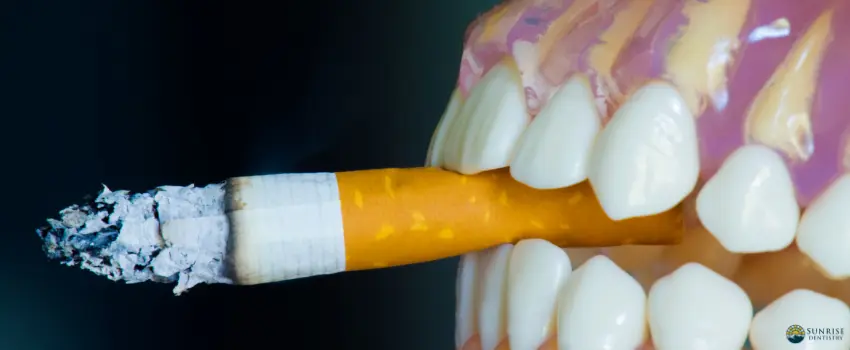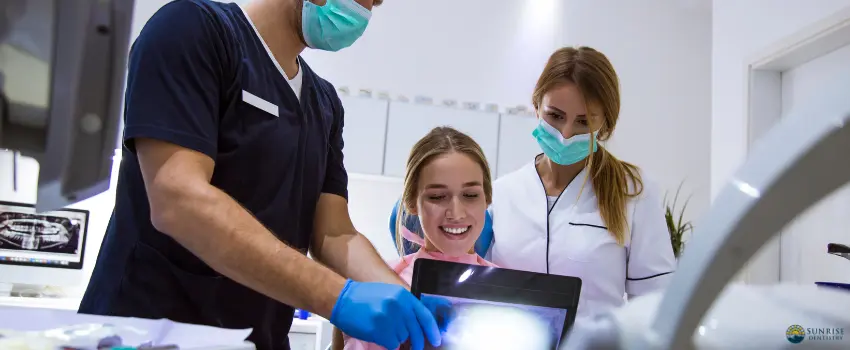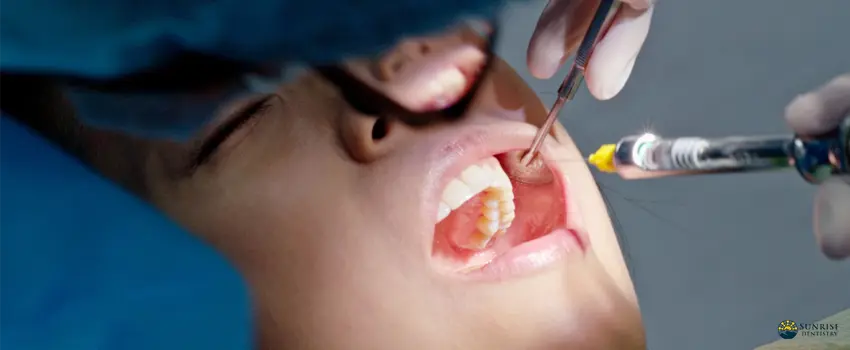Oral cancer is a formidable disease that can strike anyone, regardless of age or background. While it can be a scary diagnosis, it’s important to remember that early detection and treatment can greatly improve the chances of recovery.
As April marks Oral Cancer Awareness Month, now is the perfect time to shed light on this important health issue, its symptoms, risk factors, and prevention strategies so that more people can learn about this disease and take proactive steps to protect their oral health.
Causes of Oral Cancer
Oral cancer is a type of cancer that develops in the tissues of the mouth or throat. At its core, oral cancer occurs when normal cells in the mouth mutate and grow uncontrollably. This abnormal growth can be caused by a variety of risk factors that introduce cancer-causing chemicals into the mouth.
However, the causes of oral cancer is not limited to external factors alone. A major contributor to the formation of oral cancer is the alteration of DNA located in the mouth and throat. DNA changes can promote cancer cell growth by creating oncogenes or terminating tumor suppressor genes, allowing cancer cells to grow uncontrollably.
There are several types of oral cancer. Understanding each type helps identify any symptoms and develop the most appropriate treatment plan. The different types of oral cancer include:
- Squamous Cell Carcinoma is the most common type of oral cancer. It develops in the squamous cells that line the mouth, tongue, and lips.
- Verrucous Carcinoma is a type of oral cancer that is rare and usually occurs in the mouth’s mucous membranes.
- Minor Salivary Gland Carcinoma develops in the minor salivary glands found throughout the mouth and throat.
- Lymphomas are cancers that develop in the lymphatic system, which plays a crucial role in the body’s immune system.
- Melanoma is a type of skin cancer that can develop in the mouth, although it is relatively rare.
Oral Cancer Symptoms
Detecting oral cancer early is crucial for successful treatment. Familiarizing yourself with the symptoms is the first step in identifying oral cancer at an early stage. Oral cancer symptoms can manifest in various ways, including:
- Pain or soreness in the mouth
- Difficulty swallowing or chewing
- Changes in speech or voice
- Swelling or lumps in the mouth
- Bleeding or numbness in the mouth
- White or red patches in the mouth
- Pain or tenderness in the face, neck, ear, or mouth
- Weight loss
Risk Factors for Oral Cancer

The development of oral cancer is often associated with a range of risk factors. Understanding these risk factors is essential in taking preventive measures to decrease the likelihood of developing this life-threatening disease. Here are some of the most common risk factors for oral or mouth cancer:
1. Alcohol Consumption
Excessive alcohol consumption is one of the leading causes and risk factors for oral cancer. Chronic alcohol consumption can damage the cells in the mouth and throat, making them more vulnerable to cancerous growth.
2. Tobacco Products
Tobacco products are another major oral cancer cause and risk factor. Cigarettes, cigars, and smokeless tobacco all contain cancer-causing chemicals that can damage the cells in the mouth and throat. Long-term use of tobacco products significantly increases the risk of developing oral cancer.
3. Exposure to Secondhand Smoke
Exposure to secondhand smoke is also a risk factor for oral cancer, especially for non-smoking individuals. Research suggests that exposure to secondhand smoke during childhood may increase the risk of developing oral cancer later in life.
4. Compromised Immune System
Individuals with a weakened immune system are also at a higher risk of developing oral cancer. People with HIV, organ transplant recipients, and those with certain health conditions are more prone to developing the disease.
5. Human Papillomavirus (HPV)
Certain strains of the human papillomavirus (HPV), a sexually transmitted infection, have been linked to the development of oral cancer. HPV-16, in particular, has been linked to tonsil and tongue cancers. Vaccination against HPV can potentially lower the risk of developing oral cancer, although further research is needed to confirm this.
Additional causes and risk factors that can contribute to the development of this cancer include:
- exposure to the sun;
- inadequate consumption of fruits and vegetables in your diet;
- age and genetic predisposition;
- previous history of oral cancer or other cancers;
- use of betel-quid, a common practice in certain cultures that involves chewing a mixture of betel nut, tobacco, and other ingredients;
- poor oral hygiene habits; and
- regular use of alcohol-based mouthwash products.
How Do Dentists Detect Oral Cancer
Oral cancer screening is an essential part of routine dental care. It allows for the early detection of cancerous and pre-cancerous cells in the mouth, dramatically increasing the chances of successful treatment. Here’s how screening for oral cancer generally goes:
1. Initial Visual Inspection
During the visual inspection, the dentist will use a bright light and a small mirror to examine the lips, gums, tongue, cheeks, and the roof and floor of the mouth. They will be looking for changes in color or texture, sores or patches that don’t heal, and any lumps or swellings.
2. Extra-Oral Examination
The extra-oral examination involves checking the neck, jaw, and other areas of the head and face for any lumps or abnormalities. The dentist will also ask you about any oral cancer symptoms you might have experienced, such as pain, difficulty swallowing or speaking, or changes in your sense of taste.
3. Biopsy Test
If your dentist suspects anything abnormal during the screening, they may take a biopsy or refer you to a specialist for further testing. Biopsy involves removing a small piece of tissue from the affected area and examining it under a microscope to check for cancerous cells.
Oral cancer screening is not a definitive diagnosis of cancer. However, it can help detect early signs of cancer, which can greatly improve the chances of successful treatment. Regular dental check-ups and oral cancer screenings are vital for maintaining good oral health and preventing serious health complications.
Oral Cancer Prevention

Maintaining a healthy lifestyle and seeking regular dental check-ups is the best way to prevent oral cancer. Here are some tips for reducing your risk of oral cancer:
1. Avoid smoking and tobacco use.
Smoking is one of the most significant risk factors for developing oral cancer. Quitting smoking can significantly reduce your risk of developing oral cancer. It is also crucial to avoid all forms of tobacco use, including chewing tobacco and snuff, as they increase the risk of oral cancer.
2. Drink alcohol in moderation.
Excessively drinking alcohol is another risk factor for developing oral cancer. It is important to drink in moderation, which means up to one drink per day for women and up to two drinks per day for men. However, not drinking alcohol at all is the best way to reduce the risk of developing oral cancer.
3. Avoid prolonged exposure to the sun.
Exposure to the sun can increase the risk of developing oral cancer. Protecting your lips and skin from the sun by using lip balm with SPF and wearing a hat when you are outside for extended periods can help reduce your risk.
4. Eat a balanced diet with plenty of fruits and vegetables.
A balanced diet rich in fruits and vegetables can help reduce the risk of developing oral cancer. The nutrients and antioxidants found in fruits and vegetables can help strengthen the immune system, which can help fight off cancer cells.
5. Get vaccinated against HPV.
Getting vaccinated against HPV, if eligible, is one way to significantly reduce the risk of developing oral cancer. The vaccine is recommended for both males and females and is typically given between the ages of 11 and 12.
6. Seek regular dental check-ups for oral cancer screenings.
Regular dental check-ups are essential for maintaining good oral health and detecting any issues early. Dentists can perform oral cancer screenings during these check-ups, which involve a visual examination of the mouth and throat for any signs of cancer. Early detection can significantly improve the chances of successful treatment.
Key Highlight
Oral cancer is a serious health concern that can be avoided or treated successfully with early detection and proper care. It’s important not to wait until you experience symptoms to get screened for oral cancer. Regular dental check-ups, including oral cancer screenings, are crucial in maintaining good oral health and preventing oral cancer from developing or progressing.
Stay proactive with your dental care with expert help from Sunrise Dentistry.
Regular dental check-ups are an essential part of maintaining healthy teeth and gums. At Sunrise Dentistry, we provide comprehensive oral health screenings, including oral cancer screenings, to ensure that any potential dental problems are detected early on.
Our state-of-the-art facility is equipped with advanced technology to help us provide you with accurate diagnoses and effective treatments. Our team of dentists in Pagosa Springs, CO, have the skills and expertise to help you achieve your dental goals. Contact us today and take the first step towards a healthier, happier smile.





